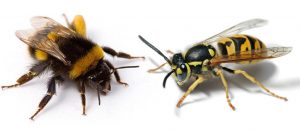
A wasp by any other name doesn’t smell as sweet
By Lauren Paulsen, Contributor
Everyone knows what a bumblebee is: a fat, fuzzy, black and yellow insect, commonly believed to defy the laws of physics with its flight. Something I’ve noticed, however, is that people seem to have a hard time telling the difference between honey bees and wasps, when the truth is, they aren’t even of the same family. Bees come from the family Apidae, whereas wasps come from the family Vespidae.
Calling wasps “bees” all the time creates a misconception that they are the same, when this is far from the truth. People’s fear of stinging insects is understandable, and results in our not wanting them near us, but truthfully bees will rarely sting unless threatened (like being stepped on) or if they feel their hive is threatened. Honestly, they’ll only sting as a last resort, because for a poor bee, stinging means death. It is a highly unpleasant death because large animals have skin that is too thick for a bee’s stinger and therefore it becomes stuck, literally ripping the bee’s abdomen off. If they are lucky, sometimes their entrails are attached. I can only imagine how painful this must be.
When a bee is flying around you, it’s only interested in your perfume or brightly coloured clothes. It’s merely curious, and will leave shortly after figuring out you aren’t a flower. They’re peaceful when buzzing around the garden, and won’t bother you if you don’t threaten them.
In general, most wasps are also peaceful and won’t bother you unless you harm them. There are certain members of the family that aren’t so peaceful, however. One such species is the yellow jacket. It is the most common wasp to be called a bee, having the same colours. These insects can be quite a nuisance. These wasps are more likely to sting, because they will actually keep their stinger afterwards. They can sting as many times as they want without worrying about dying and they release a pheromone that causes nearby yellow jackets to become agitated and start stinging as well. This is a good survival strategy for them, but for us, it’s just plain bothersome—and painful. Of course, they won’t sting you without reason, but they’re more aggressive than bees and can become agitated more easily. The most common way to be stung by them is if you’re eating outside and they come to investigate the food, or you’re near their nest.
I don’t understand the habit of calling anything striped black and yellow a bee. The only things I can think of that wasps and bees have in common is their colour, they have wings, they have a colony that revolves around a queen, and they are insects. The only reason they are both coloured the same is that black and yellow stripes warn other animals that they sting, just as the bright colours of poison dart frogs tell us they are highly poisonous. It’s nature’s warning flag. Despite living in a colony revolving around a queen, their behaviour is quite different. Wasps are actually carnivores and hunt other insects. This benefits us because it means less of other pests. Bees and wasps don’t even use the same type of venom when stinging. Someone who’s allergic to bees may not be allergic to wasps, and vice versa.
I think it’s important that people understand the difference between bees and wasps, and that they educate themselves about their differences. Imagine if we were called monkeys all the time because we share similar features. Don’t give the bee such a bad rap by calling it a wasp. They are actually quite peaceful.

